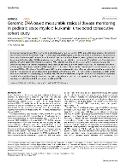Genomic DNA-based measurable residual disease monitoring in pediatric acute myeloid leukemia: unselected consecutive cohort study

Autor
Skořepová, Justina
Meyer, Claus
Marschalek, Rolf
Novak, Zbynek
Domansky, Jiri
Datum vydání
2024Publikováno v
LeukemiaRočník / Číslo vydání
38 (1)ISBN / ISSN
ISSN: 0887-6924Metadata
Zobrazit celý záznamKolekce
Tato publikace má vydavatelskou verzi s DOI 10.1038/s41375-023-02083-9
Abstrakt
Measurable residual disease (MRD) monitoring in childhood acute myeloid leukemia (AML) is used to assess response to treatment and for early detection of imminent relapse. In childhood AML, MRD is typically evaluated using flow cytometry, or by quantitative detection of leukemia-specific aberrations at the mRNA level. Both methods, however, have significant limitations. Recently, we demonstrated the feasibility of MRD monitoring in selected subgroups of AML at the genomic DNA (gDNA) level. To evaluate the potential of gDNA-based MRD monitoring across all AML subtypes, we conducted a comprehensive analysis involving 133 consecutively diagnosed children. Integrating next-generation sequencing into the diagnostic process, we identified (presumed) primary genetic aberrations suitable as MRD targets in 97% of patients. We developed patient-specific quantification assays and monitored MRD in 122 children. The gDNA-based MRD monitoring via quantification of primary aberrations with a sensitivity of at least 10(-4) was possible in 86% of patients; via quantification with sensitivity of 5 x 10(-4), of secondary aberrations, or at the mRNA level in an additional 8%. Importantly, gDNA-based MRD exhibited independent prognostic value at early time-points in patients stratified to intermediate-/high-risk treatment arms. Our study demonstrates the broad applicability, feasibility, and clinical significance of gDNA-based MRD monitoring in childhood AML.
Klíčová slova
Measurable residual disease, hildhood acute myeloid leukemia
Trvalý odkaz
https://hdl.handle.net/20.500.14178/2402Licence
Licence pro užití plného textu výsledku: Creative Commons Uveďte původ 4.0 International







